



05





05
Wednesday
APRIL DINNER
6:00pm for 6.30pm start
With guest speaker Dr John V Basarin OAM who will be presenting ‘Gallipoli Campaign; The Eastern Connection’.
DineIn: Members $39, non-Members $44.
13
Thursday
RAMADAN AFTAR DINNER
6:00pm – 8:00pm
Open to all members and their guests. Free for Resident Members, non-Resident Members $17, non-Members $22.
14
Friday
SPECIAL MORNING BREAKFAST
7:30am – 8:30am
Special breakfast beverage for residents at Graduate House. Free for Resident Members, non-Resident Members $14, non-Members $20.
19
Wednesday
WOMEN’S FORUM
10:00am for 10:30am start
The topic of this forum is “The Republic: Do we want one and what form should it take?”
The Women’s Forum group welcomes new members. Forum discussions are held in an informal and friendly atmosphere.
21
Friday
MEMBERS DRINKS NIGHT
5:30pm onwards
Come along in your own groups or come meet new friends and enjoy a relaxing, convivial, no fuss wind-down to your working week. Members and non-Members prices apply.
05, 12, 19, 26
BRIDGE NIGHT
7:15pm – 9:30pm
Wednesday
Join us for Bridge Nights every Wednesday evening. All levels of bridge players welcome. Player fees: Members $2, non-Members $5. Food and beverages at bar prices.
FOR BOOKINGS: phone: (03) 9347 3428
email: membership@graduatehouse.com.au
website: www.graduatehouse.com.au
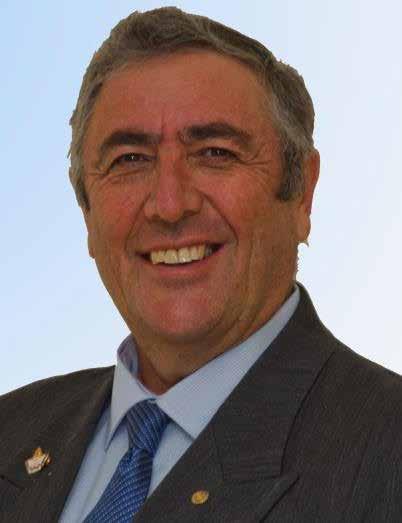
Thursday, 13th April 2023
6:00pm — 7:30pm
Resident Members: Free / Members: $17.00 /non-members: $22.00
RSVP: Thursday, 6th April 2023
In Islamic culture, Iftar is the evening meal after sunset that breaks the daily Ramadan fast. We invite you to join us at this event for an evening banquet and celebration. We welcome guests of different faiths and cultures.

Entrée
Lentil soup with lemon (v, gf)
Main Course (served from the servery)
Boneless roast chicken thighs with roz bil khalta
Mint yoghurt lamb cutlets with roz bil khalta (meaning of roz bil khalta – a traditional favourite, Saudi style white rice with Baharat, pine nuts, raisins and almonds)
Pita Bread
Vegetarian option
Mousaka
From the salad bar
Fattoush
Dessert
Dates stuffed with walnuts, Baklava, Oum Ali, Fresh fruits
Come along in your own groups or come meet new friends and enjoy a relaxing and convival wind-down to your working week.
Guests and non-Members are welcome
Friday, 21st April, 5.30pm onwards at Graduate House, 220 Leicester Street, Carlton
Drinks at Members and non-Member’s prices.
To book: call 03 9348 3428 or email admingh@graduatehouse com.au
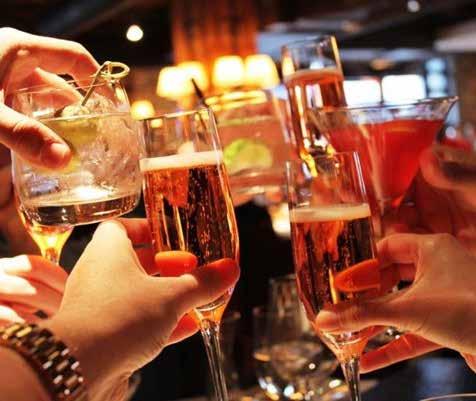
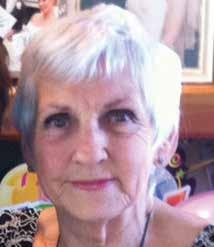
Tuesday, 16th May 2023
Hybrid event
A Joint Presentation by
Gail Southwell (General Manager) and Kate Turbitt (Marketing and Engagement Manager) at 3MBS Fine Music Melbourne will be presenting on Community Radio and in particular, 3MBS and the evolution of the station over its forty-seven year history.
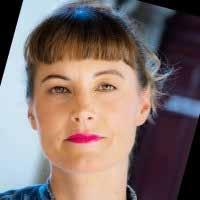
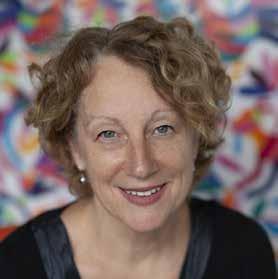
Time
Attending at Graduate House
7:00pm pre-dinner drinks in the Members’ Lounge
7.30pm dinner in the Ian Potter and Stillwell Rooms
Joining online for the presentation
7:45pm link is provided when registering
RSVP by Tuesday, 9th May 2023
Phone (03) 9347 3428
Email membership@graduatehouse.com.au
Online bit.ly/3lgpvkm
Venue Graduate House, 220 Leicester Street, Carlton
Tickets
Attending at Graduate House
$39 Members (non-resident)
$17 Members (Resident)
$44 non-members
Joining online for the presentation
$10 Members
$15 non-Members
We are proud to announce that, as of February 2023, we hold reciprocal arrangements with The City University Club in London. This is the fifth club in London to be affiliated with The Graduate Union.
The other four clubs are
• The Burn - Goodenough College, Mecklenburgh Square
• The Oxford and Cambridge Club, Pall Mall
• The Royal Society of Medicine, Wimple Street
• St. James Club and Hotel, St. James
Address:
42 Crutched Friars, London, Greater London England, EC3V 3PD
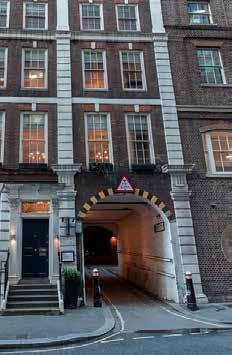
Phone: 020 7863 6681, Fax:020 7626 8572
Website: https://www.cityuniversityclub.co.uk/home
The City University Club (CUC) is a lunch club in the heart of the financial area of London. The dining rooms offer a quiet haven in the heart of the city for members and their guests and is an ideal place for a drink at the bar or meals at modest price.


Originally established in 1895 by Oxbridge graduates who wanted a lunch club in the city, the link with the universities remains and membership is now much wider, embracing both genders and professions from many fields.
The Club moved to their current location at Crutched Friars in January 2018. These premises used to be the residence of the Spanish Ambassador during the late 18th century.
Members and their Reciprocal partners’ members find the atmosphere conducive to lunching with friends or on their own at the club tables. Besides the food being first-class; the wine-list is comprehensive and the service is excellent. Comfortable spaces are available for business purposes, from early morning hours. Private rooms are also available for hire 7 days a week for breakfast, lunch and dinner.
Lunch is served from 12noon, with last orders accepted till 14.30pm and the Bar is available for prelunch and post-lunch drinks.
Here are some features of the Club:
• Wheelchair-accessible lavatory on ground floor.
• WiFi ia available and members of staff are happy to charge your phone if needed.
• The premises is a smoke free.
• Members who find stairs difficult are welcome to eat at the Bar on the ground floor, where the full Dining Room menu is available, alongside a Bar menu.
• Step-free access is available via the passage to the side of the premises
The Club is open for lunch from Monday to Friday throughout the year, closing only between Bank Holidays, Christmas and the New Year.
In keeping with rules of other private members clubs, the dress code is jacket and tie for men and smart dress for ladies (no jeans or trainers).
The Club enjoys reciprocity with over 450 of the finest clubs throughout the world including many in London and other parts of the country.
Wednesday 1st March
Dr Harry Blutstein spoke about his latest book, How can they call it Murder. The book is about the murder trial of Barbara Eckersley. At the luncheon, Harry provided a back story of the victim, the accused and explored the legal and moral issues that this case had raised.

A few years back in April 2021, I heard about a murder trial of Barbara Eckersley in New South Wales, who was charged with murdering her 92 year old mother, Dr. Mary White by feeding her a dose of substance called Nembutal (green dream drug).
There has been a debate on the practice of euthanasia with laws in every state in Australia but these laws only go so far — this is about the end of life, except that it’s been hobbled by a range of conditions that makes it very difficult to access. As a result, they are based on a particular principle and that is ‘sanctity of life’, a religious term meaning God has given life and only God can take it away. So in effect we might be living in a circular society but abiding by this principle. There is an alternative principle in liberal society – that we shouldn’t have the state telling us when to die, it is our choice as adults. People who are desperate and those dying in agony take the law in their own hands, as Barbara Eckersley did in August 2018. She ended the life of a loved one and was charged with murder. How could an act of kindness be treated as Malice aforethought. (Malice aforethought is described as a criminal act that was deliberately planned to cause harm to someone.)
The trial was held in Goulburn, NSW, in April over three weeks. It was fair to say that both the defence and prosecutor were very civilised and it was more as if the prosecutor was very understanding of Barbara’s situation. I would like to quote an opening by Crown prosecutor Paul Kerr, who described the charge that Barbara’s action ‘was done with love and compassion and of course in pain and sorrow. It was very compassionate and sympathetic, but nevertheless unlawful.’
Paul Kerr told the jury that ‘murder’ was an ‘emotionally charged word’, which did not accurately describe Ms Eckersley. Mr Kerr described Ms Eckersley as a loving and caring daughter, who was
facing trial because she did not have a lawful reason for her actions that required planning and deception.
Barbara was 68 years old at that time. Her mother, Dr Mary Elizabeth White (AM), was a renown environmental scientist and author, notable for collecting numerous plant fossils for the Australian Museum, describing a number of new plant fossil species, and authoring several well received, large format science books for the general readership and successors. Had she not died the way she did, she would have received glowingly, one of Australia’s female greatest scientist Geology journal. It was however, a sad ending. This case was prosecuted as a murder trial, so the barristers were only interested in very narrow criterias - Did she plan to kill her mother? Did she intent to kill her mother? Did she succeed in killing her mother?
The trial also considered manslaughter – Did she know what she was doing? Did she understand the consequences of her action? Did she know right from wrong? Can you treat a mercy killing in the same way? Can she get up and say, yes what I did was wrong?when infact she did believe that it was not only right but it was morally right. It was a humanistic thing to have done. Firstly, we need to understand the relationship between mother and daughter – there was a strong tie between the two that made Barbara do what she did.
Mary was brought up in southern Rhodesia, and her ambition was to have a large family like her parents had, and she succeeded. Barbara was her second child and her mother’s favourite child, and Mary made that known to everyone. Their relationship was enormously strong. Mary was a stay at home mom who worked on paleontology for a mining company. She could age rock based on the fossils that were in them. Big drums of fossils were delivered to their house in Hunters Hill and she would go through them, write reports and that was how she developed
her expertise in paleontology. She was a great net worker and was very resourceful with knowledge. She would develop contacts around the world on her field and had the ability to take the broader view. She hadn’t made many publications in that area but she understood the flow of geological time and evolution which she put into her books. She was a brilliant scientist in a conventional way. She had the ambition to marry a nice man, have a large family like her mother. Her husband was also a geologist. Mary stayed at home with their children and they travel widely. To Mary, the greatest joy was to be in the countryside with her family, hunt fossils and take the family along, in particular, Barbara, who developed a great love for nature.
Sadly, Mary’s husband died of cancer when she was in her 60s and with the kids grown up, Mary decided to write a book, The Greening of Gondwana – The 400 Million Year Story of Australia’s Plants(1986). It was meant to be a coffee table book, to be read by all, with gorgeous photos taken by famous photographer Jean Fraser (recently deceased) who was also the photographer for English broadcaster and biologist, David Attenborough. David is an admirer of Mary White’s work. Mary’s book appeared in most school and university libraries. After the book, Mary was involved with the environment and produced other excellent books. She then decided that she wanted to venture into practice and so purchased a large forested property, Falls Forest Retreat, and established a covenant to protect the land and preserve its biodiversity.
Before long, she was getting mini strokes, transient is-chemic attack (TIA) and forgetful. Barbara suggested that Mary move into a granny flat in Bundanoon and so for the next 2 ½ years, Barbara cared for her mother. Situations at home were sometimes dangerous - things got burnt, Mary was not able to cook her own meals anymore, so they had meals on wheels and Barbara sometimes took her mother out. Mary was not driving anymore, she was unable to cross the roads even though her eye sight was still good.
During this time, Mary made a couple of statements: that were not revealed in court. One woman whom Mary worked with said, that Mary told her, if she ever had a major stroke she would want to take a pill and end it all. She had made her views on euthanasia very clear. She had said the same thing to her other children, also to the worker who cleaned her flat, so there was no question that she would find it intolerable to ‘one day have a stoke and end up in a nursing home.’
In February 2016, that was exactly what happened. Mary had a major stroke and was paralyzed one side, she couldn’t speak and was admitted to Warrigal nursing home. Barbara would visit almost everyday
to feed her mother. She often fought with the carers to try alleviate to make her mom comfortable. Mary would be grimacing, crying and trying to throw herself off the bed. The problem was that she couldn’t talk so there was no way of knowing if it was pain or discomfort. Mary was totally dependent at this stage, she was hand-fed, double incontinenced, changed and turned every 3 hours. She could not hear nor speak, ... so here was a brilliant mind trapped in a body of solitary confinement which was considered torture.
After a few months in the nursing home, Mary regained a little speech and told Barbara to ‘please kill me’, which was not unusual. At a meeting with doctors, when they were arguing about alleviating the pain, in frustration, Barbara’s husband, Richard had said ‘you wouldn’t treat a dog like this, you would put the dog down’. This was quoted in court as evidence, and was taken as an intention to murder Mary. The statements were made mainly by Richard and Barbara because both supported euthanasia and the law at that time in NSW was taken as an intention to kill.
With the back story given here, it was vitally important to understand the anatomy of mercy killing. But of course the court was not interested in understanding - they were aiming for what little defence she had – which was very very thin.
On Sunday, 4th August 2018, before Barbara went into the nursing home, she crushed eight Temazepam tablets in a mortar pestle, then carefully put them into a sauce bottle, brought it to the nursing home. She fed her mother dinner and then added them to her mothers custard dessert. She was only planning to put half (which was still double of what an adult would take under normal circumstances) and as she said in court, it all shot out. This of course was treated by the court as the first attempt of the murder of her mother’s life. Her mother had a good nights sleep and the next day Barbara went in again.
Twenty years ago, Barbara had been involved as a carer who helped injured animals. She had phenobarbital, also known as ‘green dream’ drugs and had told the court she had the drugs leftover from two decades ago when she was a wildlife carer in Canberra.
So Barbara (who had these drugs from 20 years ago) filled them in a syringe and took them into the nursing home. When she arrived, Richard was there watching tv, and supposedly did not see what she was doing. Barbara added them to her mother’s soup. Mary started to cough after taking a little of the soup and her breath became gurgling and she became very unresponsive. Barbara then rushed out and told the nurses that her mother was having a turn - a turn is a medical term - the nurses then came in and returned Mary to a recovery position and Mary began calming
down. The nurses then rang the doctor, who prescribed a sedative called Midazolam, which was injected into Mary’s thigh. So Mary now had two strong sedatives, and both together would certainly have killed her - phenobarbital alone might not have but both together probably led to her death.
The doctors action should be in question - here is a woman who was barely conscious, lying on her side and he just recommended a major sedative. This didn’t seem right, especially the manner in which Mary was treated - this doctor clearly did not know her and here is part of the cross examination of the doctor to indicate that: Palliative care is not a particularly satisfying form of medical aid because the care serves to alleviate pain and not cure - the patient was dying soon anyway, depending on the situation that they are in - and this had certainly been the case with Mary White.
Mary’s doctors receive regular updates from the nurses on her condition. Her family had a great interest in her discomfort and were putting pressure on the doctors about the medications given to her. Barbara wanted her mother to be sedated for most of the time so that she would not know what was going on. It was also hard not knowing what Mary wanted, as she couldn’t talk but was trying to throw herself off the bed (which she succeeded a few times) and she was often crying. I spoke to her son David, and there was evidence suggesting that in this fog of dementia, she was also going into vascular dementia, even though dementia does not mean a patient becomes immediately mentally incapacitated and are unaware of their situation. I believe that on a number of occasions, Mary realised where she was. In these moments of despair, Mary knew exactly the situation she was in and Barbara had said her mother was always pleading with her eyes...so eventually, on that Sunday night, 5th August 2018, Dr Mary White died.
The next day Barbara went to the funeral parlour to make arrangements for the cremation. Barbara had worked on Tuesday, then went to the police station but did not mention feeding her mother with Temazapam nor the green dream drug. However, the next day, (8th August), Barbara handed herself to Moss Vale Police Station out of fear of implicating her husband for her mother’s death. When asked what she thought would happen after she fed her mother green dream drug, Barbara told the police ‘I thought she would go to sleep and have reduced pain and distress’.
Barbara was arrested, charged with murder, and sent to the cell. The prosecution wanted to jail her (Goldburn Jail) until her trial - which meant two years behind bars…this was happening to a 67year old woman who had just lost her mother and best friend.
However, thanks to the magistrate – Barbara was released on a range of conditions. Barbara saw her lawyers the following Monday to correct her record. Firstly, she had told the police that she fed both drugs to her mother on the same night - and if that was the case - there’s not question that she wasn’t just going to give her mother a good nights sleep (which was what she was arguing for) -she was trying to kill her.
Phenobarbital wasn’t going to make Mary sleep, but the dream drug would kill her while she was asleep. Barbara also said ‘it is not my intention to kill my mother’ - so she was negating her confession. She said ‘I’m now remembering what I was thinking that night and that wasn’t the case’.
Dr Mary White had two doctors when she was admitted to Warrigal aged-care home. There were many conflicts between the doctors and Barbara regarding the medication. Barbara and Richard were always pushing for Mary to be sedated and implying criticism on the doctors. When it was brought up in court ‘you wouldn’t treat a dog like this, you would put the dog down’, Richard denied this and claimed that all he did was discuss that the law should be changed to allow people like Mary to die.
May I say that, had the laws been in place in NSW at the time, Mary would not have qualified — she was not within 6 months of dying, was not in agony, and despair was not something that euthanasia laws would consider. And she had no disease that would kill her within twelve months.
Thankfully there was a third person, the head of nursing at this conversations, and the only one who remembered the exact words being said because she was upset as they were said near the bed that Mary was lying in – the very reason she remembered them. She had said, ‘you should never make such conversation next to Mary’s bed’. This was interpreted as a cry from the heart.
Now comes the second doctor in question. The doctors would drop in occasionally, and they would get feedback from the nurses and adjust the medication accordingly. This doctor wasn’t doing any wrong but in this court case, he was being questioned and criticized for the way he was caring for Mary. He had said, ‘they wanted me to sedate her all the time, I wasn’t going to allow that because I balance pleasure and pain. She did experience pleasure and I wanted her to have that pleasure and not sedate her all the time. And in fact to proof my point, in July (Mary died in August) at the mid year Christmas festivities, she was able to enjoy ginger pudding, roast turkey and wine and she enjoyed looking outside the windows at the kangaroos. I wasn’t going to deny her these things’.
The defence lawyer remembered the Christmas event and had gone through the files from the recreation officer. At the cross examinations were these questions, Did you see her eating? Did you know that all she could eat was liquefied food? Did you know she was a teetotaler? Do you know she was almost blind (indicated on her medical file) so she couldn’t have been looking outside at kangaroos? And her window didn’t look out to kangaroos outside.
And there were other functions like Melbourne Cup Day - How did you think Mary would have enjoyed that? As he went on, it showed how much this doctor knew of his patient. This is the doctor who had made a statement and placed himself as the one to judge that she should suffer pain so that she could enjoy all these imaginary pleasures. This dreadfully showed how little empathy this man had for his patient and was immune to what was happening to Mary.
Dr Mary White was a 92 year old lady. She had a major heart attack, had four stents inserted, and had transient is-chemic attack (TIA). She was going to die at some stage (which she did that night), and of natural causes, but she just happened to die within three hours of being fed with Nembutal. It was not a strong argument. The real argument here was on manslaughter, Barbara had said ‘I didn’t really know what I was doing, I wasn’t in control of my actions’.
The Prosecutor said this about Barbara’s actions‘You crush the tablets. The fact that you had the idea to need to crush them up to transport them was a conscious decision. It took intelligence, and you then filled in to a small container, then took great care to seal it, you used the pestle then place it back in the kitchen cabinet, then went into the nursing home etc… and then there’s the question of the autopsy, you only confessed after you knew about the autopsy’. So it was a very very steep mount for Barbara to climb.
While it is not known what led to the decision, nor what went on behind the jury door, but there is a phenomenon called jury nullification (occurs when the jury in a criminal trial gives a not guilty verdict regardless of whether they believe a defendant has broken the law), an American term, not common in Australia. So there was always the possibility that the jury did the same. The verdict was manslaughter and Barbara Eckersley was sentenced.
This is where treating mercy killing as murder is so unjust because what Barbara had to do to make sure she didn’t spend the next 25 years in jail was to express remorse for being kind to her mother. She had to deny the love of that act to get off and that is wrong, in my opinion.
And then there’s the argument for manslaughterthis phrase was used by the forensic psychologist because one of the criterias was knowing right from wrong. He asked if she knew what she did was morally wrong. There is a difference between legally wrong and morally wrong and Barbara Eckersley would have argued that what she did was morally right, and had she been asked that question directly, I think that would have been her answer and so treating it as murder means that she has to run through hoops.
I have studied cases of mercy killings and judges do not ask during the sentencing that ‘if you pleaded guilty, made a full confession - you must be remorseful’.
I didn’t realise it at the time but in most mercy killing cases, (there are more than one a year), there never is one consistent trial. Barbara’s trial was unusual, she did not expect to plead for manslaughter and be wanted for murder with a lengthy sentence, hence the reason it went to trial, and this case had provided a unique view into mercy killing.
With euthanasia laws now in place, we may see the number of mercy killings increasing and nurses and doctors may argue that it is less excusable, and that these cases needs to be reported. There are many people out there who are not within the six months of dying nor in agony. So what can we do about it? This problem was first raised in 1974 by an organisation called Dying With Dignity Victoria Inc (DWDV), formerly the Voluntary Euthanasia Society of Victoria Inc. The government was urged to deal more sympathetically with the mercy killers in light of the values of the Victorian community. Unfortunately, nothing was done. New offences of mercy killing will allow judges taking into account motives and sentencing. Since then, other countries like Germany and Switzerland in particular, have new criminal code called Homicide on request - begging to be killed. Compassion homicide should be considered which would be the case of Dr Mary White who couldn’t request because she couldn’t talk. There is ongoing support for this among legal community. In other mercy killing cases, everyone from the police to the lawyers and judges are very uncomfortable treating mercy killings as murder.
Justice Betty King, (now retired) asked the question, should people be put before the criminal courts for acting out of love? In my view, they shouldn’t.
Thank you, Dr Blutstein, for that very interesting insights into the murder trial of Barbara Eckersley. Harry’s book How do they call it Murder, will be published in early 2024.
A natural storyteller, Harry also spoke at our College Table on 2019 on Social Studies. We look forward to welcoming Harry again in the near future.
I am new resident at Graduate House, after having lived in a number of countries. It seemed the right time to reflect on the past and to hope for the future. Here is a personal essay about (slowly) becoming bilingual French-English over the years, and becoming a professional translator along the way.
My mother tongue is French and I love my native language. As a citizen of the world, English has become my beloved second language. The English language is a bridge between all of us in our global world. It helps us to communicate with each other and to better understand one another.
Reading in English, listening in English, speaking in English, writing in English, working in English, cataloguing in English, researching in English, interviewing in English, and “of course” translating from English to French - this has been quite a ride so far.
I tried to learn English at school but at that time, most English teachers were not native English speakers. The courses were so packed with students that we mostly listened and hardly ever uttered a word, except for whispering a joke in French to the student sitting next to us.
After several years, I could remember a few verses of Shakespeare but I was unable to order a sandwich. When I was 15 years old, I went on a school trip to England. I visited London to know Paris’ sister city, and Stratford-upon-Avon to have a glimpse of Shakespeare’s birthplace. But the trip was too short to boost my English skills.
My first conversation in English as an adult was painful.
I was a librarian in a small harbour in Normandy to self-fund my master’s degree at The University of Caen. The public library was the last one in France with no lending library. After cleaning 10,000 books to get rid of mice, (dead) snakes, (living) spiders and tons of dust, I created a lending library for adults and children, and a reference library for everyone.
The reference library hosted a collection of maritime books. An Englishman crossed the Channel to see the collection. My few sentences in English were barely understandable. I was appalled at myself, and sadly realised that all these English lessons at school had been a total waste.
The next day, I hurried to the local chamber of commerce to subscribe to an English course. The experience was short lived because I have never been good at learning in a formal setting.
In the pub next to the library, I met with a native English teacher who was there for one year. We decided to team up once a week over cider, beer or wine. He would speak French half of the time to improve his French, and I would speak English half of the time to improve my English. The experience was successful this time and we both made significant progress.
After five years as a librarian 24/7 — I was also in charge of exhibitions, conferences and concerts — I went to London for three months to regain my sanity before going back to Normandy to participate in regional projects.
Then I went to Jerusalem as a librarian and cataloguer. I worked with everyone — Christians, Jews, Muslims, Israelis, Palestinians, Ethiopians, Armenians, and more. I learned some Hebrew and some Arabic, but I mostly worked in English and in French. When I was working in English, I found it easier to understand non-native English speakers than native English speakers.
Back in Europe, I worked for international organisations, where English is the lingua franca. My spoken English improved. I catalogued international publications, and occasionally translated web pages and working papers, which helped to improve my written English.
After a number of cataloguing assignments, I couldn’t see a pile of printed books any more. To cut a long story short, I got an overdose of printed books. I was saved by electronic books (ebooks) that became my passion, and the subject of a PhD later on.
From 1995 onwards, I tried to spend a few months per year in San Francisco, California, a mythical city for us Europeans. My spoken English improved drastically while sharing life with my housemates in the Mission District. My spoken Spanish improved too.
I became a professional translator from English to French so that I could work flexibly, and wrote a PhD thesis for the Sorbonne on ebooks around the world, based on many email interviews.
As a number of people I interviewed didn’t speak French, I offered an English version of my thesis to thank them for their time. To self-translate more than 100 pages from French to English was a difficult and exciting experience.

I never attended university classes in person for my BA, my master’s degree and my PhD (granted in 2000). I worked full time all along to pay the bills, and studied full time all along with a thirst for knowledge. Nights were short.
Twenty years later, this is still what I do — I am a translator to pay the bills while pursuing my true passion: researching and writing on topics I am interested in, first on ebooks around the world, and then on translation and translators. I also translate my own writings along the way.
My research was first published by the NEF (Net of French Studies) at The University of Toronto, Canada, before being available in three languages (English, French, Spanish) in Project Gutenberg and in the Community Texts of the Internet Archive. Everything is freely available to all with a Creative Commons licence. My French articles are published in the online journal ActuaLitté
Despite being granted two US green cards for “extraordinary ability” in 2006 and 2016, I was not able to secure a good job or a fellowship in a major university or research centre, although I tried hard for several years.
From what I understood, what seems important is to have a strong record of publication in highquality academic outlets, and to have (or to be able to attract) significant external funding. I had none of those. I could only offer a meaningful research project having an impact on many people, first a research project on ebooks around the world, and then a research project on the working conditions of professional translators.
I tried my luck in Silicon Valley, but the good jobs are only for computational linguists. All of us — renamed language specialists, linguistic specialists, translation specialists, localisation specialists, editing specialists, content reviewers or linguistic testers — are offered short temporary assignments and paid US$20plus an hour.
We are asked to localise software or video games, to translate or trans-create marketing or creative content, and to work on voice recognition projects. The money goes to the language service providers that employ us, and to the project managers who check on us. We — the people who actually do the work — can barely earn a living but no one seems to care. I learned a lot about the gig economy in the field of languages.
I have now moved to Australia, and was recently granted a global talent visa and permanent residence. I look forward to working as a translator and/or a librarian in the Asia Pacific.
I am contactable at: marie.lebert@gmail.com, and my website is: http://marielebert.wordpress.com
Graduate House marked 60 years as a Residential College in 2022. Part of our anniversary celebration to commemorate this significant milestone was to hear from our Residents and learn first hand what it’s like to live here and their aspirations while on their academic pathway.
In January 2022, Emeritus Professor Martin Comte, a member of The Graduate Union Council, initiated this interview series and very kindly devoted his time each month to sit with our Residents to learn about their experiences while in residency as well as offer mentoring advice.
By popular demand, these interviews are back and in this issue, Martin sits with Jo Palazuelos-Krukowski from USA and Jeevan Soundarajah from Singapore.
Jo, I am fascinated with your background and what brought you to be living in Graduate House and working with The University of Melbourne.
Thanks Martin, it’s lovely to get the chance to speak with you today. I am Argentine-American: I emigrated to the United States with my family when I was a child. I think growing up between the Argentine and American communities generated a fascination with cultures different from my own pretty early on. I also fell in love with storytelling, and the ability it has to create new worlds. I ended up studying anthropology at Grinnell College, and I worked a bit in television and media after I graduated. I realized I wanted a bit more international experience, so I spent a few pretty amazing years teaching English in South Korea and getting involved with the theatre companies in Daejeon and Seoul. There I discovered how much I loved teaching, and the power that theatre has to foster community and a unified sense of purpose.
With that I decided to pursue my doctorate in theatre in the United States. My research focus began with a basis in folklore and performance, and how community stories were adapted for the stage. I developed a particular interest in ghost stories. My Masters thesis was dedicated to Japanese ghosts on the nineteenth century kabuki stage, and how the figure of the ghost is used to interrogate outstanding
sociocultural tensions regarding gender, identity, and class. As I carved out my dissertation project, I also found myself drawn to exploring multimodal forms of storytelling. I fell into studying radio as its own kind of theatre, and understanding how sound has a pretty magical ability to transform the spaces we inhabit. I have a couple of great Australian friends that I had met on my travels as well, and some fortuitous circumstances led me, in 2019 to the Australian horror radio scripts held in the collections at the Arts Centre Melbourne (ACM) and the National Film and Sound Archive (NFSA). I was told by the archivists at the NFSA that 2023 was the hundredthyear anniversary of Australian radio broadcasting. With that, I proposed a research initiative with the Fulbright Commission to spend a year developing podcasts, exhibitions, and live performances to honor Australia’s rich and under-explored horror radio legacy. The Fulbright said yes, and I’m very happy to be working in Melbourne for the next nine months.
And do you know that the new CEO of Fulbright Australia is Dr. Kerry Bennett, the former CEO of the Graduate Union?
Yes! She is why I’m at Graduate House, actually. The accommodation I had arranged for my stay in Melbourne fell through, and so I called the Fulbright Commission, and explained my situation. Twenty minutes later I received a call to say that there was a

room for me at Graduate House, that I could check in straight away, and that I could stay as long as I liked. I’ve been in residence since mid-January. It was a pretty incredible surprise to arrive and have a built-in community of international scholars and people who are curious and dedicated to what they do. You get to learn so much about their diverse fields, and you get to experience this city with them. I’ve gotten to build friendships with people from all over the world, from all walks of life, and in different eras of their lives. It’s a bit like college – but for adults! [Laughs]. Everyone is so kind, so smart, and driven. It’s great.
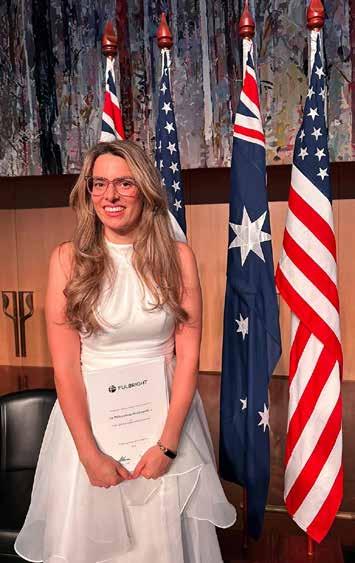
Hopefully I’ll finish by the end of this year or early next year.
I’m delighted that you’ve come to Graduate House for your final year. You’ve already mentioned many things that you’ve liked in the short time you’ve been here. We’re always trying to improve on the experience we offer residents – have you any suggestions?
I think that having communal breakfast and dinners provided by Graduate House really lends itself to cultivating those friendships with the other residents. Every morning and every evening you see the same faces, with everyone asking each other how their day went, and sharing their experiences. You’re living that journey together. There are lots of social events to bring people together, like seeing free opera in Fed Square, or ballet at the Sidney Myer Myer Bowl. They host special dinners for holidays, or serve you fancy hot chocolate and designer coffee for breakfast. Simple things like hanging out in the library and playing cards, reading and studying together – it’s a nice home away from home.
I’ve had the fortune to live in a fair number of countries before this, and I just think that Melbourne is one of the most liveable cities. Melbourne has small-town friendliness with a big city’s social life. We’re in a cultural hub where you can see and experience one-of-a-kind art exhibitions, theatre and music. I feel lucky to be able to do this project based out of Melbourne, and maybe build some connections to spend more time here. My plan is to work as a university professor, either in the US or abroad, but I also love theatre, production and events – so if I were to go into the practical performance field I would be happy as well. While I’m
in Australia I’ll be researching with the State Library of Victoria, the ACM and the NFSA to develop those radio centenary events. I’m looking forward to directing a staged reading of Spectral Frequencies, a play I adapted from a series of Australian horror radio scripts, here at the University of Melbourne’s Victorian College of the Arts. The show first premiered at the University of California-Santa Barbara in February 2022. We had a wonderful and talented cast of fourteen American actors and soldout shows. Whilst I’m here I’m very much looking forward to working on this play with Australian actors, speaking these lines in the nation they were written in.
Jo, I love your story and am so pleased that you’ve chosen Graduate House – or perhaps one of its ghosts arranged for it to choose you! I wish you all the best with your dissertation and I can assure you that I will be one of the first to read it when it is published. I have been fascinated to learn about your journey in choosing a topic – and one centred in Australia! Thank you for such an informative and affirmative interview.
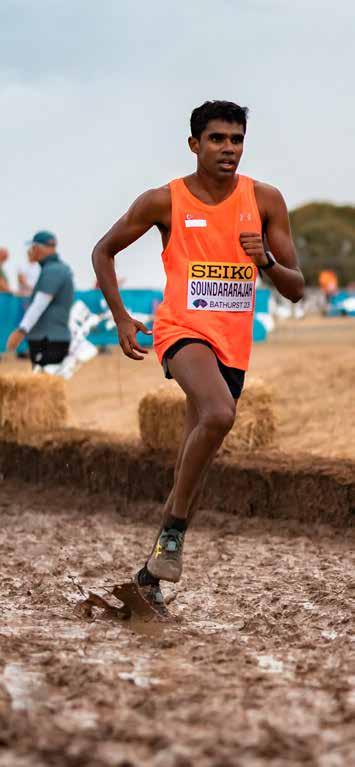
Many thanks for agreeing to be interviewed. Tell me something about your background in relation to your studies. I understand that you went to high school in Singapore, and did you go straight to university after that?
I’m currently studying for a Masters degree in Engineering Management at The University of Melbourne. I was born in Singapore and did my education there. After high school in Singapore I completed two years mandatory national service in the army. After that I went to the National University of Singapore to study mechanical engineering. During this period I also went on a student exchange to Loughborough University in the UK. After graduating I worked for slightly more than three years in the renewables industry, focusing on solar systems. I came to Melbourne to study in July last year. I am also a national athlete for Singapore and represent my country in the middle to long distance events. Currently, I’m training with The University of Melbourne Athletics Club and I take part in the various competitions held in Melbourne, and recently I had the opportunity to represent Singapore at the World Athletics Cross Country Championships in Bathurst. It was a good experience: I had to run against Kenyans, Australians, Sudanese and others who are very highly placed on top of the field. It was a tough, ten kilometre course with many obstacles – hills, sand, and mud [laughs]. I met quite a lot of runners on the Australian team, including several from Melbourne. I was on the team bus going back to Sydney with them before catching the flight to Melbourne. I often see some of them when I’m training here. It was my first experience at representing my country at a world level, and great experience in terms of the competition.
Congratulations! What a wonderful experience and honour to represent your country. I’m most impressed. You’ve been living at Graduate House for seven months: how did you come to choose it?
I was looking for accommodation near the campus and I knew that there would be Masters and PhD students around my age whom I could easily interact with – people who had already reached a certain academic level of study. (I used to live in an undergraduate hall in Singapore at a different point of
time). I also only have to walk about ten minutes to where I train – so everything just came together here at Graduate House. In terms of the convenience and the interactions I’ve had, it was a good decision.
We’re always trying to improve on the experiences for residents, so I like asking the people I interview for suggestions on how we can do it even better.
I think that the personal space is fine; I have my own quiet space. In terms of daily interactions, we usually meet during breakfast or dinner. The responsibility is normally on us to speak to others: perhaps it would be nice if there were ways where those who are shy or quiet could be connected with others. I find that residents usually connect on the basis of where they come from; students from each country tend to sit together. (But I don’t know if there is anybody else from Singapore living here). Perhaps the Graduate House Barbecue and similar events could be where broader interactions occur – by introducing people and pointing out that they share some common interests. I would like the opportunity to meet people from other cultures, including some European countries, for example. I think that people could also be connected through a sharing of similar interests or topics. Perhaps we could have a social night weekly or fortnightly and suggest two or three topics that people could speak on and discuss. Or people from different countries could talk about where they come from.
This is such an interesting suggestion. And I think that some students would also enjoy hearing what others are studying or doing in their research. I have no doubt that many people would be very interested to learn about your involvement in athletics – and at an international level. All residents have interesting stories to share; our challenge is how to go about this. I really like your idea of a regular social event for the sharing of interests, backgrounds and ideas. Certainly, I know that some students are very passionate about certain topics, including sport, theatre, fishing, and just exploring Melbourne. And I know that some weekends small groups of students have taken a train or bus trip for a day or two to visit a regional town in Victoria.
I’ve been to the Mornington Peninsula and the Great Ocean Road (but it was a bit rushed because we were on a bus tour). And I recently I went to Bendigo and went sixty-one metres underground down an old gold mine. I now have my own car (I received it from my sister who lives in Queensland) and in my free time I want to explore Victoria more. For example, I want to go to The Grampians. I’ve also been to Adelaide; I prefer the beaches there, and it’s much more peaceful than Melbourne. Another place I want to visit is Tasmania.
You won’t be disappointed: I love Tasmania. Actually, for someone who has only been in Australia for seven months, you’ve already managed to visit some interesting places. You were saying to me earlier that you would like to stay on in Melbourne after you graduate, not only to gain more experience in your engineering field but also because of the better training opportunities for your athletic pursuits.
Yes, the culture is different between Singapore and Australia and I think there is a better balance between work and leisure here. I have more time for my running and I currently compete in races in Box Hill, Maribyrnong and Albert Park. And I went to the Victorian State Championships just recently.
Let’s try to look into the future, say in ten years’ time: what would you like to be doing?
My next step will be to find work – something that I can balance with my running. The Commonwealth Games will be held in Melbourne in 2026, so that gives me something to aim for over the next three years. It won’t be easy, but I could have a chance to represent Singapore. The running culture in Australia is that you just keep training over the years. Of course, I will need to balance this with work. And I hope I will find someone and settle down – maybe through my running. [Laughs]
I wish you every success in that endeavour! Was there anything that surprised you when you came to study at The University of Melbourne? Was it much like studying at university in Singapore? I realise of course that you were studying at the undergraduate level there, and now you’re working at the graduate level.
It’s less intense here. I’m doing four subjects each semester, whereas in Singapore I was studying five or six subjects. I find that I can spend more time on the learning process; I don’t have to rush. Here there is more of an emphasis on ‘understanding’. In Asian culture we get the knowledge but we don’t ask many questions or ‘Why?’. And, as I said before, there is a better ‘balance’ between work and leisure, I feel.
Jeevan, it has been such a privilege to interview you. I wish you every success with your running and your studies. And I hope you will continue to represent Singapore in your athletic pursuits for many years to come.
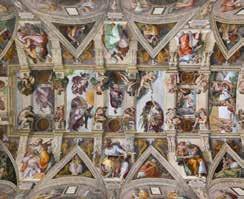
Many years ago, together with my family, we visited Florence. It was winter and this incredible city was denuded of the suffocating tourist population that has come to pollute the incredible testament to the Renaissance. We had it to ourselves and walked amongst the ghosts of genius who created this testament of the uninhibited creativity of the human spirit. The tower of Giotto astride the Duomo; two of the most extraordinary examples of inspired architecture in the world not to mention the perfection of the craftsmanship that was so integral to their completeness. And then we would walk alone amongst the squares of the City and stumble across works of Michelangelo, some complete but more interesting were those where he had only managed to release a part of a magnificent human body from the prison of a marble slab. Gradually, in this quiet tomb of yesterday I was overcome with a sense of sad beauty and I wondered if we had lost or forgotten something in our accelerating momentum towards what we call “The future”?

I wanted time to stop so that I could be held in a time warp of beauty. In the end, all I could take with me from Florence were those precious memories. I try to forget my most recent visit to Florence when it was overrun by endless groups of tourists jostling with endless other groups to get a glimpse of something or hear a bit of nonsense from the guide with the umbrella and microphone. Then there were the stalls selling leather rubbish and people being ripped off right left and centre. I left the City appalled, trying to remember it as it was those many year ago. And I let my mind wander. I became preoccupied with this idea, this concept, this indefinable filament of life we call “beauty” that it becomes compelling.
Who are these people who create beauty? I immediately thought of the American artist Jackson Pollock, the creator of my favourite piece of art “Blue Poles”. Now, a lot of people are untouched by this painting but when I look at it I wonder what demons drove Pollock to squirt his oils endlessly

over the canvas until a point was reached when he stood back and was satisfied he had finished his work. I would have liked to ask him “how do you know it is finished”. I would hope that he would have said “because I have reached into my depth and have released the beauty that was within me.” Then I thought of Michelangelo releasing bodies from their prisons of marble. And then I had an avalanche. All the genius of humanity flood my mind. Tchaikovsky and the final heart breaking movement of his first piano concerto that stirs my soul. And then the names and how they have touched me and brought beauty out of me tumble into my awakened self. Mozart, Beethoven, Rachmaninov, Monet, Rembrandt, Van Gough, Cezanne, Shakespeare, Tolstoy, Dostoevsky and so many more who have reached deep into themselves and found their beauty and shared it with the world.
The world should be saturated with so much beauty that I should sob with tears of gratitude for the privilege of experiencing its touch. But alas, The reservoir of beauty that has accumulated over the years hasn’t preoccupied the world with its blessings as we find ourselves rushing to the future encumbered with all of the interruptions of modern society. But I have this belief that beauty can change the world if we seek deep in ourselves as have the likes of Jackson Pollock or Shakespeare. Perhaps in each one of us, there is something beautiful within us that needs expression. Perhaps everyone has their moments of beauty that we can bring to the surface and share it with the world. Perhaps If each day everyone on this planet could stop and dig deep into themselves to find that tiny piece of beauty that lies within them and needs to be free so that it will touch others, the reservoir of beauty might one day overcome the world and make it more beautiful. And then beauty might spread like poppy seeds and the world would sob with tears of joy that would renourish our destiny.
The Committee meet every two months and these meetings have been held at Graduate House for the last few years. One feature of the Committee meetings for at least the last 60 years (and this practice still continues) is its guest speakers who are usually academic staff of the University whose topics are about their teaching, research and community service activities. The Committee is unfailingly impressed by their dedication to their role in the University and is looking at ways to make these guest speakers’ talks more widely available to graduates. Another feature of the Committee meetings (for at least 60 years) has been that most members stay for dinner afterwards, originally at University House but now at Graduate House, which they find most enjoyable for the informal discussion and as a social gathering.
Whilst the Committee of Convocation can no longer claim to be representative of graduates, it does from time to time make respectful representations to the University and the government on issues which it thinks are important.

The term ‘convocation’ means any gathering of people, but in academia it usually means a gathering of academics or graduates having some role in university governance or a graduation ceremony.
A quick Google search shows that The University of Western Australia and The University of New England have a formal convocation, and that universities in the United States, Canada and India, for example, also have formal convocations. In some universities the term is applied to graduation ceremonies. For example, the web site of Arcadia University in Canada (https://convocation.acadiau.ca/ history.html) states :
Convocation reaches back to the earliest days of university history when scholars and masters were summoned together for a legislative or deliberative assembly. The granting of degrees is an honour bestowed by the assembled university on those whom it wishes to distinguish for a variety of reasons.
Oxford has a Convocation House, where the annual Vice-Chancellor's Oration is usually delivered.
At The University of Melbourne, the present Committee of Convocation has its origins in the University Senate, constituted by the University
Act 1853 which established ‘An University consisting of a Council and Senate...’. That Senate consisted of all graduates who first met in 1867 when they first numbered 100. From that date, the Senate had to approve every new amended or repealed statute or regulation made by the University Council. The Senate also appointed the members of the University Council.
The University Act 1881 changed the membership of the Senate to just male persons with Masters or Doctors degrees, and reiterated that members of the Council were to be appointed by the Senate.
The University Act 1913 removed the requirement that members of the Senate be male persons.
The University Act 1923 stated that ‘The University of Melbourne shall consist of a council and convocation’.
The number of members of the University Council was increased to a maximum of 36, of which 10 were to be appointed by convocation. It also explicitly stated that ‘Convocation shall consist of all graduates’, and established a ‘Standing Committee of Convocation” of not less than 40 persons who are members of Convocation, and was to meet at least annually. Hence the Senate ceased to exist.
The University of Melbourne Act 2009 stated that the University consisted of essentially the Council, the staff, the graduates, the students, some staff members of affiliated colleges, and Emeritus Professors. It did not mention convocation or the Standing Committee of Convocation. This meant that the Committee of Convocation ceased to have any role in University governance.
However, the Committee of Convocation is still recognised as a graduate association, operating quite independently of the University, and its members retain their deep interest in, is concern for, and desire to contribute to the University, arising from their appreciation for what the University has done for them. They regard their time at the University as a privilege rather than as a right, and perhaps have a somewhat old-fashioned idea of how the University should be serving the Victorian community.
Partial closures of Grattan Street have been in place since 2018 as works on the new underground Parkville Metro station have continued, which has seen motorists become accustomed to “rat runs” and peak hour delays in the area.
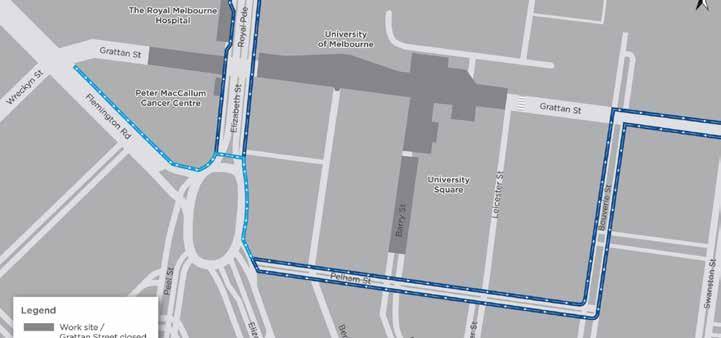

But with road reinstatement and public realm works getting under way mid this year, questions have been raised about whether the new sections of Grattan Street would be reopened to traffic as pledged by the City of Melbourne and Department of Transport and Planning (DPT).
“We were promised all the way through this development that Grattan Street will be reopen” Rob Moore, president of the Parkville Association, said, adding the City of Melbourne “have not been forthcoming”.
Residents were now worried that Grattan Street, which will become single lanes each way, would only be reopened to buses and bikes, not cars.

Story source: https://www.innercitynews.com.au/
Link to story: bit.ly/3Jq1z7e


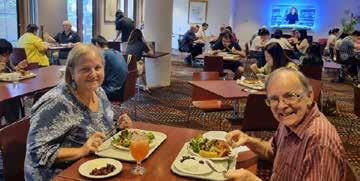

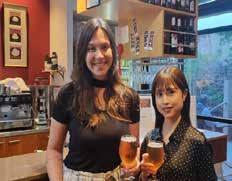

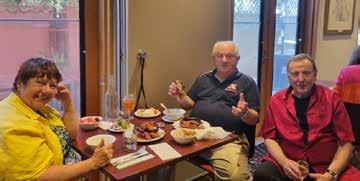
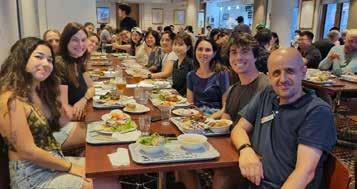

A big thank you to all residents, members and guests who joined us for this year’s Summer Welcome BBQ on Friday 24th February, 2023. It was absolutely wonderful to see so many familiar and new faces and we look forward to a wonderful year ahead. A special thank you also to our chefs for the amazing food and all the Graduate House staff who made this evening possible.

Councilors and Members of The Graduate Union congratulates Dr Kerry Bennett for her new appointment as Executive Director at Fulbright Australia Commission, Canberra.

Dr Bennett was the CEO/Head of College of The Graduate Union from 2011 till October 2021. Kerry enjoyed her time at Graduate House and miss, particularly the wonderful members and staff. We wish her the very best in her new role.
Rosie Maddick and friends came together on Friday, 3rd February to celebrate her birthday. The private event was held in a formal setting in the Johnson library.
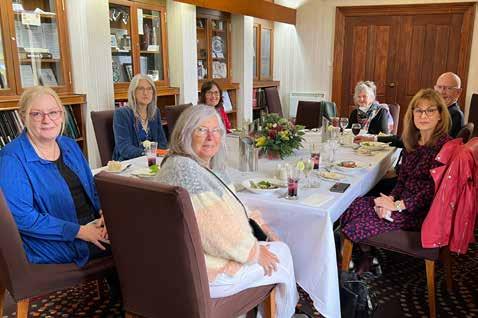
Rosie is a Life member of The Graduate Union, was on Membership and Marketing Committee working group in 2014 and is a regular attendee to our collegiate events.
We wish Rosie the very best for her birthday!
The Graduate House Student Group (GHSG) is a student association aimed at promoting socialisation and encouraging a feeling of community amongst the residents of Graduate House.
Membership affiliation with GHSG is free and open to all residents.

The membership entitles you to be part of our community, get involved and participate in all the activities organised by GHSG. Join us to participate in fun events such as movie nights (with snacks!), outings, sports day and more! This is a great opportunity to unwind from your busy university life and make some new friends.
To become a member, simply fill in your information here bit.ly/409xnTt. The only requirement to participate is that you must be currently residing in Graduate House.
GHSG is affiliated with the Graduate Student Association (GSA) of The University of Melbourne. For more information, contact us at gradhousestudentgroup@gmail.com.
Here is your opportunity to become a part of our team. Come crack some jokes and plan some cool activities with us!
Don’t worry, there’s barely any work to do. Plus, we get to hang out, so it’s a win-win!
The first Melba luncheon club meeting of the year featured Professor Kate White as speaker. Kate was a co-founder of Melba Club which is a networking group for women of diverse backgrounds interested in social and professional issues.

She was also a one-time student resident of Graduate House and was married from Graduate House.
Kate is an Adjunct Professor at Federation University and has had a decades long career in gender leadership in Higher Education. She has co-edited four books on this topic for the network: Women in Higher Education Management ( WHEM ) of which she was co- founder and director from 2007 to 2022. This network now has representatives from fourteen countries.
The statistics she presented on women’s participation in higher education are alarming. While 50% of Universities population is female, women occupy 66.4% of professional administration, 44.7% of academic staff, but only 20.5% of vicechancellor positions.
Kate outlined multiple factors influencing this under representation, from the personal choice of some
women to more satisfactorily combine work and family, to the finding that some University managers actively ignore gender inclusion policies.
She said that some managers are unsupportive of flexible work practices, particularly the requirement to travel between campuses at regional universities, while many women dislike the present blokey, cutthroat, organisational culture.
The meeting ended with a lively discussion on the issues she had raised, and also a very interesting anecdote by Kate on her choir connections for the name Melba Club.
by Elizabeth OwenIf you are interested in being part of the Student committee, talk to us or write to us at gradhousestudentgroup@gmail.com.
The following vacancies are available:
Secretary - The Secretary is responsible for taking minutes during meetings and circulating them among members. They also design the agenda for committee meetings and remind members of things that need to be discussed.
Sports Coordinator - The Sports Coordinator is responsible for organizing sports events for Graduate House members, ideally, at least one per month. Anyone who is enthusiastic and passionate about sport is strongly encouraged to run for this position.
Publicity Coordinator - The Publicity Coordinator is responsible for advertising events to Graduate House members. From making posters to promoting events on social media, we need a creative mind and keen salesperson to share the committee’s ideas and initiatives with residents.
The newly elected Student Committee 2023 (so far):
• President - Claudia Arce Ojeda
• Vice President - Vitoria Hagemann Cauduro
• Treasurer - Martin Veron
• Events Coordinator - Johanna Palazuelos-Krukowski
• Secretary - vacant
• Sports Coordinator - vacant
• Publicity Coordinator - vacant
Science Gallery at The University of Melbourne launched its third exhibition, Break the Binaries, on 18th February, with works centred around sharing people’s personal journeys with identity.
Developed in discussions with young people and an academic advisory group, Science Gallery director Dr Ryan Jefferies said the topic of identity in terms of gender, race and sexuality stood out as a theme of interest.

“We work closely with young adults from a range of backgrounds to discuss potential topics for exhibitions, and gender and identity continue to be themes of personal and universal relevance,” he said.
Drawing on an exhibition that was held at Science Gallery London, called GENDERS: Shaping and Breaking the Binary, Science Gallery Melbourne has created a playful, non-traditional gallery space with around 12 works from local and international artists.
An open call for submissions also resulted in a wide range of multidisciplinary works, from video to sound, sculpture, and multimedia, all of which explore a diverse and unique range of topics and ideas close to each creator’s heart.
Upon entering the exhibition, attendees are first met with George Goodnow and Simona Castricum’s bent steel sculpture work Wayfinding, which has fake street signs with words running along the entire structure.
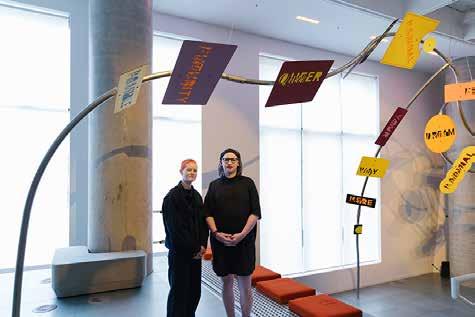
The artists described their work as an exploration of the ideas of safety, possibility, and visibility from a queer trans perspective.
The gallery space then opens up to a burst of colour and activity.
Ash Hem’s UN(COMFY) encourages people to reach a place of being “comfortable with the discomfort that comes with being uncomfortable”.
The work invites people to sit comfortably on pillows as they listen to an audio mix of anonymous voices sharing their personal experiences of being confused with identity.
Other works focus entirely on multimedia, such as Zeth Cameron’s work Queervoice 101 – an interactive video installation that touches on elements of voice training, and challenges understanding of how voices may change in different settings and what this means.
Overlooking the entire gallery from each and every corner, are six large-scale “superheroes”, illustrated by Yuri, Torres Strait and South Sea Islander Dylan Mooney.
For more information, go to:
melbourne.sciencegallery.com/breakthebinaries
Exhibition curator Tilly Boleyn said Break the Binaries aimed to present a playful, welcoming and kaleidoscopic view of the chosen topic.

“Through the personal perspectives shared and interdisciplinary creative practice grounded in research, all of these works are intended to create connections and conversation,” she said.
Break the Binaries will be at the Science Gallery at The University of Melbourne until 17th June. Entry to the exhibition is free.
The heroes don’t replicate what is seen through many movies, but instead reimagine them as characters who get strength and pride from who they are and their culture.
Story source: https://www.innercitynews.com.au/ Link to story: bit.ly/425axhP
Action Education
Advancement Office Senior Advancement Leadership Team session
Australian Society for Music Education (ASME) Victorian Chapter - Council Meeting
Association of German Teachers of Victoria Inc. (AGTV)
Carlton Rotary
Department of Infrastructure Engineering Staff Meeting
First Super executive Planning Day 2023
Integrated Marine Observing Stystem Group meeting
Melba Group Luncheon
Melbourne Climate Futures EV Forum
Melbourne School of Professional and Continuing Education (MSPACE), The University of Melbourne
Mosaic Lab and new Democracy Foundation
Order of St. John of Jerusalem
Knights Hospitaller Incorportated
Parkville Conference of St Vincent de Paul Conference Meeting
Peter MacCallum Cancer Centre - People Leadership Fundamentals
Probus Club of Carlton
Rosie Maddick - Everything's Rosie: A Happy Birthday Lunch for a Happy Woman
Royal Australian Chemical Institute (RACI)
Rulethirteen
Social Education Victoria
Stroke Association of Victoria
The Australian & New Zealand Association of Psychiatry
Psychologhy & Law (ANZAPPL)
The Graduate Union Collegiate Events and Governance Meetings
We thank the following organisations for their event bookings at Graduate House in January and February 2023
220 Leicester Street, Carlton, Victoria 3053, Australia
Telephone: +61 (0)3 9347 3428
Australian Business Number: 55 610 664 963 Incorporated Association Registration Number: A0023234B
ww.graduatehouse.com.au
